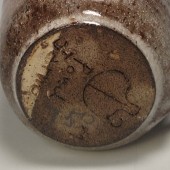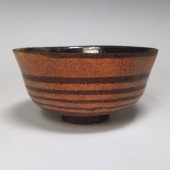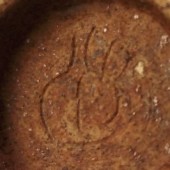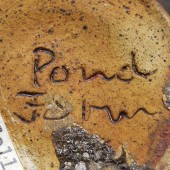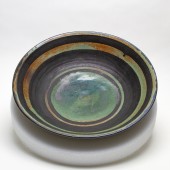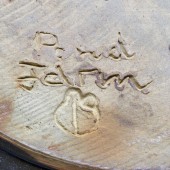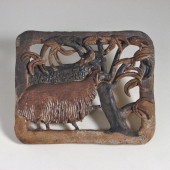![]() Printer version
Printer version
Marguerite Friedlaender Wildenhain
1896Born Lyon, France
1985Died Pond Farm, California
EDUCATION
UnknownWoodcarving, School of Fine and Applied Arts, Berlin, Germany
1919-1926Ceramics, Bauhaus, Weimar, Germany
WORK EXPERIENCE
1925-1933Ceramics Instructor ,School of Fine and Applied Arts, Halle (Saale), Germany
1925-1933Designer, Royal Berlin Porcelain Factory, Rudolstadt
1933-1940Studio, Het Kruikje (Little Jug), Putten, the Netherlands
1940-1942California College of the Arts, Oakland, California
1949-1952Pond Farm craft school, Guerneville, California
1952-1979Independent Studio Potter and Summer Workshops, Pond Farm, Guerneville, California
Marguerite Wildenhain made functional stoneware with abstract, tactile surface decoration either glazed, incised or both. She typically marked her work with a small jug motif inscribed in the well of the foot.
Wildenhain trained at the Bauhaus in Weimar from 1919-1926. While in Germany, she made over 50 designs for Royal Berlin Porcelain Factory, some of which remained in production for over 75 years, and taught at the Municipal School for Arts and Crafts in Halle. In 1933, together with her husband Frans, she set up her first pottery studio in Holland. Seven years later in 1940, fleeing the Nazi regime, she moved to the United States.
Wildenhain's friends and art patrons, Jane and Gordon Herr, had purchased land in California to build an art school based on the Bauhaus model. The project was short-lived but Wildenhain stayed on, transforming the land, Pond Farm, into her home and studio. Each summer she taught a handful of dedicated students, encouraging them to be highly disciplined in their work-ethic. Wildenhain saw no distinction between craft and fine art. She encouraged her students to pursue careers as independent studio potters and not to consider teaching positions if they did not want to be teachers. Wildenhain believed in selling her pots directly to customers and not relying on retail merchants. After moving to California, Wildenhain, along with Gertrud and Otto Natzler, was one of the first studio potters to use a kick wheel in America
Wildenhain made ceramic sculptures towards the end of her career influenced by her early training in woodworking and sculpture.
An interview with Marguerite Wildenhain conducted March 14, 1982, by Hazel Bray for the Archives of American Art's Oral History Program is available at:
http://www.aaa.si.edu/collections/interviews/oral-history-interview-marguerite-wildenhain-12152.
PUBLIC COLLECTIONS
Alfred Ceramic Art Museum, Alfred University, Alfred, New York
Brunnier Art Museum, Iowa State University, Ames, Iowa
Crocker Art Museum, Sacramento, California
Los Angeles County Museum of Art (LACMA), Los Angeles, California
Luther College Fine Arts Collection, Saskatchewan, Canada
Museum of Arts and Design, New York, New York
Scripps College, Claremont, California
Smithsonian American Art Museum, Renwick Gallery, Washington, DC
BIBLIOGRAPHY
Behrens, R.R. Recalling Pond Farm: My Memory Shards of a Summer with Bauhaus Potter Marguerite Wildenhain. Bobolink Books: Dysart, Ipwa, 2005.
Kath, R., ed. The Letters of Gerhard Marcks and Marguerite Wildenhain, 1970-1981: A Mingling of Souls. Ames, Iowa: Iowa State Press, 1991.
Schwarz, Dean and Geraldine, eds. Marguerite Wildenhain and the Bauhaus: An Eyewitness Anthology. South Bear Press Decorah, Iowa, 2007.
_______, Dean and Geraldine, eds. Centering Bauhaus Clay: A Potter's Perspective. Decorah, Iowa: South Bear Press, 2009.
Sessions, Billie. Ripples: Marguerite Wildenhain and Her Pond Farm Students. San Bernardino, California: Fullerton Art Museum, 2002.
Wildenhain, Marguerite. Pottery, Form and Expression. Palo Alto, California: Pacific Book Publishers, 1962.
_________, Marguerite. The Invisible Core: A Potter's Life and Thoughts. Palo Alto, California: Pacific Book Publishers, 1973.
Pond Farm with jug motif hand inscribed in foot well.
Citation: "The Marks Project." Last modified September 3, 2025. http://www.themarksproject.org:443/marks/wildenhain
















